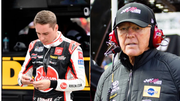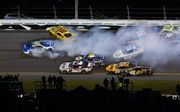
via Imago
BROOKLYN, MI – AUGUST 06: Alex Bowman 48 Hendrick Motorsports Ally x Detroit Pistons Chevrolet and Denny Hamlin 11 Joe Gibbs Racing Mavis Tires & Brakes Toyota make their way down pit road during the NASCAR, Motorsport, USA Cup Series FireKeepers Casino 400 on August 06, 2023, at Michigan International Speedway in Brooklyn, MI. Photo by Joseph Weiser/Icon Sportswire AUTO: AUG 06 NASCAR Cup Series FireKeepers Casino 400 EDITORIAL USE ONLY Icon230806032

via Imago
BROOKLYN, MI – AUGUST 06: Alex Bowman 48 Hendrick Motorsports Ally x Detroit Pistons Chevrolet and Denny Hamlin 11 Joe Gibbs Racing Mavis Tires & Brakes Toyota make their way down pit road during the NASCAR, Motorsport, USA Cup Series FireKeepers Casino 400 on August 06, 2023, at Michigan International Speedway in Brooklyn, MI. Photo by Joseph Weiser/Icon Sportswire AUTO: AUG 06 NASCAR Cup Series FireKeepers Casino 400 EDITORIAL USE ONLY Icon230806032
There are instances where NASCAR races are decided by the finest of margins, we all witnessed the thrilling three-wide photo finish at Atlanta last year. While the race car drivers and the race car get all the plaudits, the pit crew are often the unsung heroes. But, that is not the case anymore as with the Next Gen car and single lug nut revolution, the pit crews are now seen as a vital cog in their respective teams. This was evident when the #11 pit crew put in a show with a 9.84-second four-tire stop, helping Denny Hamlin win the race off the pit road and ultimately grab the checkered flag at Richmond Raceway.
If we are to compare how pit stops were exercised back in the day to the modern era, technology has indeed revolutionized the sport. “If you were to take these boys now, put ’em back in the early ’60s at the race track, it would blow their minds. They could not believe how far it’s come in really not that many years, in a way. … It’ll keep escalating. Technology is unreal in this day and time,” veteran pit crew member and three-time Daytona 500 winner, Waddell Wilson said this to NASCAR.
While the premier NASCAR series is constantly pushing the limits in reducing the pit stop times, this shift has affected the lower series as well. Joe Gibbs Racing team shared the timeline on how changes in equipment and technology have made the pit stops crucial. And we just might see pit crews and teams trying to achieve 8-second time on the pit road, and that’s huge if you consider that a 12-second pit stop was the norm just a few years back.
ADVERTISEMENT
Article continues below this ad
A quick run-down through time with JGR and its split-second strategy
Since NASCAR’s early days, pit stops have evolved. Operations have precisely utilized cutting-edge technologies like computerized pit crew coordination systems and specialized equipment, such as lightweight, impact-resistant air guns for speedy tire changes. These advancements have not only drastically reduced pit stop times but also enhanced safety measures for pit crew members.
Joe Gibbs Racing on their Instagram page shared their experience referring to the lug nuts. Teams started to recognize the competitive advantage of quicker pit stops and specialized crew members were introduced for decades with constant innovations in place. The post said, “Five lugs to one lug. How did it change the pit stop times? The 2021 season was the last use of five lugs in the Cup Series. Fastest times are in the mid-11-second range while good average times were in the mid-13-second range. 2022 is the first season with one lug nut and lots of pit stops were in the mid to high nine-second range.” Well, this revolutionary change allowed the pit crews to fine-tune their routines and this was evident from the pit road action in 2024.
“By the end of 2024, it was quite common to see stops in the mid to high eight seconds. Many pit stops are starting to get into a low eight-second range. In practice, teams have started to see pit stops below eight seconds and there is a matter of time before it happens in a race. Based on predictions with current equipment it should be possible to achieve a pit stop time of about 7.3 seconds.” The No. 12 crew at Team Penske registered a four-time stop clocked at 9.175 seconds at Dover in April. Moreover, the pit crew also came in clutch for Blaney winning the battle off the pit road at the crucial race at Martinsville.
With pit stops known for their unsafe hazards and taking nearly a minute to jump over a wall and fix the car, say otherwise at the Xfinity series. Pit crew members in NASCAR undergo rigorous training programs to enhance their skills, teamwork, and coordination. The sheer focus of the crew is essential to avoid mechanical failures that disrupt the course of the driver. Any violation, involving improper fueling or uncontrolled tire, can lead to penalties like a drive-through or stop-and-go penalty.
View this post on Instagram
What’s your perspective on:
With pit stops now under 8 seconds, is NASCAR sacrificing safety for speed?
Have an interesting take?
ADVERTISEMENT
Article continues below this ad
We saw NASCAR reprimand multiple teams across all three series after the conclusion of the race weekend at Texas Motor Speedway in September last year. The No. 3 Richard Childress Racing Chevy accompanied by the No. 51 RWR Ford saw their crew member serve a 2-race suspension for loose tire. Meanwhile, the No. 27 Jordan Anderson Racing team were delivered a similar blow. So, it’s fair to say that teams are still finding the right formula between speed and safety, with NASCAR acting as the watchdog. But, where does this trend go from here? Will we say more quicker pit stops and if so, what are the trade-offs that the pit crews will have to look out for?
Trending
Quick four-tire stops equals less fuel in the race car
Ideally, the time for a four-tire stop and refuelling a NASCAR race car takes about 12 seconds. But with cheeky fuel-saving tactics on superspeedway tracks and drivers opting for quicker stops, they are playing a risky game. Remember what happened with Ryan Blaney at Gateway? His No. 12 Ford stalled on the racetrack on the very last lap of the race due to lack of fuel. Despite being in a deserving lead, he couldn’t get the job done and his teammate Austin Cindric was there to pick up the pieces and win the race.
ADVERTISEMENT
Article continues below this ad
So, there’s a fine margin in pushing the limits on the pit road and giving up major advantages on the racetrack. Kaulig Racing’s Chris Rice who once served as competition manager at RAB Racing had a unique take on this saga. “I don’t think NASCAR wants us to be much faster. You know, 11, 12 seconds is all they want to see. The only way to get faster is go to one lug nut, and I don’t ever see that coming because we’re running a stock car. A stock car, you can go in the Hall of Fame and the cars have five lug nuts — some even have six. Obviously people are going to get stronger and faster, but you’re at a point now that you can’t get the gas in fast enough to be any faster.”
Unless and until NASCAR finds a new fuel pod that can refill the tanks quickly, the pit crews will have to tread carefully in sending their cars out of the pit road. Even if they are within the reach of putting on four tire stops in under 8 seconds.
ADVERTISEMENT
ADVERTISEMENT
ADVERTISEMENT
ADVERTISEMENT







With pit stops now under 8 seconds, is NASCAR sacrificing safety for speed?